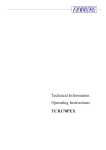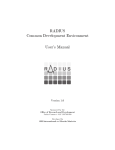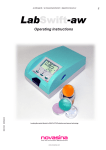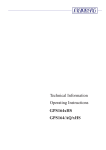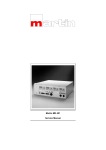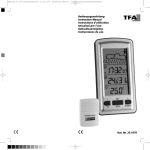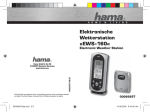Download Meinberg DCF77 PCI511 Technical information
Transcript
Technical Information Operating Instructions DCF77 PCI511 Impressum Meinberg Funkuhren GmbH & Co. KG Auf der Landwehr 22 D-31812 Bad Pyrmont Phone: Fax: ++49 52 81 - 9309-0 ++49 52 81 - 9309-30 Internet: http://www.meinberg.de Email: [email protected] May 22, 2006 Table of Contents Impressum............................................................................................ 2 Driver diskette ..................................................................................... 5 Readme file .......................................................................................... 7 General information about DCF77 ...................................................... 9 Overview ............................................................................................ 10 Pulse outputs ............................................................................ 10 Block diagram PCI511 ............................................................. 11 Connectors and LEDs in the rear panel ................................... 12 Pin assignments of the 9 pin connector ................................... 13 Installing the PCI511 in your computer ............................................ 13 Aligning the antenna .......................................................................... 14 Technical specifications .................................................................... 16 Firmware updates ..................................................................... 18 Replacing the lithium battery .................................................. 18 CE label .................................................................................... 18 Declaration of Conformity ....................................................... 19 Format of the Meinberg Standard time string ......................... 20 PCI511 component layout ........................................................ 21 4 Driver diskette 5 6 Readme file The driver diskette contains a file called „readme.txt“, which helps installing the driver correctly. The content of this file is as follows: Installation Instructions ------------------------Execute Setup.exe and choose the installation directory. By default, the installation directory is: C:\Program Files\Meinberg\MbgMon Then shut down the computer, install the Meinberg radio clock plug-in board into a free slot and reboot. Now you are asked to install a driver. The driver file MEINBERG.INF can be found in the subdirectory Driver\PnP of the installation directory. After the installation is complete, start the monitor program MbgMon. Start the time service, control the state of the reference clock and configure the device(s). Copyright (C) Meinberg Funkuhren, Bad Pyrmont, Germany 7 8 General information about DCF77 The radio clocks made by Meinberg receive the signal from the long wave transmitter DCF77. This long wave transmitter installed in Mainflingen near Frankfurt/ Germany transmits the reference time of the Federal Republic of Germany. This time reference is either the Central European Time (Mitteleuropäische Zeit, MEZ) or the Central European Summer Time (Mitteleuropäische Sommerzeit, MESZ). The transmitter is controlled by the atomic clock plant at the Federal Physical Technical Institute (PTB) in Braunschweig/Germany and transmits the current time of day, date of month and day of week in coded second pulses. Once every minute the complete time information is available. At the beginning of every second the amplitude of the high precision 77.5 kHz carrier frequency is lowered by 75% for a period of 0.1 or 0.2 sec. The length of these time marks represent a binary coding scheme using the short time mark for logical zeroes and the long time mark for logical ones. The information on the current date and time as well as some parity and status bits can be decoded from the time marks of the 15th up to the 58th second every minute. The absence of any time mark at the 59th second of a minute signals that a new minute will begin with the next time mark. Our radio clocks decode the highly accurate information on date and time within a wide range around Germany. So some of our clocks are installed in Bilbao/Spain as well as in the city of Umeå in northern Sweden - fully satisfying the requirements of the users. The radio clocks automatically switch to summertime and back. The reception of the time information is free of charge and does not need to be registered. Generally it is important to position the antenna in an optimal way. It should be mounted at least 30 centimeters away from the clock unit and from solid steel. The antenna should be aligned at a right angle to the direction of the transmitter (Frankfurt). Figure: decoding scheme 9 Overview Because the radio clock PCI511 is designed as an universal board for computers with PCI bus, operation within 3.3V and 5V systems is possible. An external ferrit antenna makes the signal from DCF77 available to the on-board long wave receiver. The demodulated time marks are decoded by the clock´s microprocessor. If no errors are detected in the current time message an additional plausibility check against the previous time message is performed. If that plausibility check passes, too, the buffered real time clock on the board is synchronized corresponding to the decoded time and date. Optionally, the decoded date and time information can be converted to another time zone. The time zone setting can be modified using the monitor program. The current setting is saved permanently on the radio clock board. Software running on the computer can read out the date/time/status and some more information. Access to the board is made via writing to/reading from I/O ports. It is possible but not necessary to let the board generate periodic hardware interrupts on the computer bus. The diskette contains a driver program that keeps the computer´s system time synchronous to the board time. If the present delivered diskette doesn’t contain a driver program for the operating system used, it can be downloaded from: http://www.meinberg.de/english/sw/ Pulse outputs The radio clock PCI511 generates pulses whenever a new second (P_SEC) or a new minute (P_MIN) begins. The P_SEC pulse is available with TTL level (0/+5V) and RS-232 level (-3..12V/+3..12V), the P_MIN signal with TTL level only. If required, DIL switches can be set up to direct each of the pulses to a corresponding pin of the 9 pin connector in the rear panel. 10 Block diagram PCI511 11 Connectors and LEDs in the rear panel The rear panel includes the antenna connector, three status LEDs, the BSL button, and a 9 pin sub D connector (see figure below). antenna free run field strength modulation BSL key RxD TxD GND The LEDs let the user check for proper receiver operation. The upper, red LED is on if the clock is not synchronous to DCF77. This LED can only change when the minute changes (seconds increment from 59 to 0). The brightness of the LED in the middle depends on the strength of the RF signal. The lower, green LED should be blinking exactly once per second corresponding to the time marks from DCF77. If this LED flickers there is some electrical noise around which prevents the receiver from decoding the time marks and synchronizing. All information given by these LEDs is also available via the monitor program. The BSL button behind the hole in the slot cover activates the clock's boot strap loader. This mode of operation is needed if the clock's firmware shall be updated. The 9 pin sub D connector is wired to the radio clock's serial port. Pin assignment can be seen from the figure beside. This port can not be used as serial port for the computer. Instead, the clock uses the port to send out Meinberg's standard time string in order to control an external display or some other external device. The string is sent out once per second, once per minute or if requested by an incoming ASCII „?“. It is also possible to change the radio clock's board time by sending such a string towards the clock. Transmission speed, framing, and mode of operation can be modified using the monitor program. The string format is described in the section „Technical Specifications“ at the end of this manual. 12 Pin assignments of the 9 pin connector When the clock is being shipped, only the signals needed for the serial port are gated to their pins at the 9 pin connector. If another signal shall be available outside the computer, the corresponding lever of the DIL switch on the board must be set to the ON position to connect that signal to its associated pin. Whenever an additional signal is connected through to the rear panel, special care must be taken to the configuration of the cable used with the connector. If pins with TTL level and RS-232 levels are connected to each other, the circuits on the board may be damaged. The table below shows the assignments of the 9 pin connector and the corresponding levers of the DIL switch: Pin Signal 1 +5V SWITCH 1 2 RxD in (RS-232) -- 3 TxD out (RS-232) -- 4 P_MIN out (TTL) 5 5 GND -- 6 (reserved) -- 7 P_SEC out (RS-232) 3 8 P_SEC out (TTL) 4 9 (reserved) -- The signals which have no lever of the DIL switch assigned are hard wired to the pins of the connector. All levers of the DIL switch which are not listed in the table are reserved and should remain in the OFF position. Installing the PCI511 in your computer Every PCI board is a plug&play board. After power-up, the computer's BIOS assigns resources like I/O ports and interrupt lines to the board, the user does not need to take care of the assignments. The programs shipped with the board retrieve the settings from the BIOS. The computer has to be turned off and its case must be opened. The radio clock can be installed in any PCI slot not used yet. The rear plane must be removed before the board can be plugged in carefully. The computer´s case should be closed again and the antenna connected to the PCI511´s coaxial plug at its rear. 13 Aligning the antenna Generally, the exact alignment of the antenna is important. It has to be placed in longitudinal direction to the transmitter (Frankfurt), see arrow printed on the label of the antenna. A distance of several meters to TV- or computer monitors, to computers or microprocessor boards should be kept. These devices can produce interference fields that lead to a poor or no DCF77 receiption. If it is not possible to mount the antenna with a sufficient distance to the computer monitor, it’s line frequency should not be close to the RF-frequency of DCF77 (77.5 kHz). The antenna should be installed with a minimum distance of 30cm to all metal objects. Otherwise the ferrite antenna will be detuned and the received power decreases. Alignment of the antenna can be done by watching the modulation and field strength LEDs. Like described in chapter „General information about DCF77“, undisturbed pulses per second (except 59. second) without any interfering pulses are required for corrcect decoding of the DCF77 time telegram. Therefore, a modulation LED blinking exactly once per second is a criterion for good receiption of the DCFsignal. Because PCI511 uses a quadrature demodulator as receive circuit, it is possible to evaluate the field strength of the DCF77 signal only. Interfering signals within the bandwith of the receiver have no affect on the brightness of the field strength LED therefore. If the radio clock is installed in the computer, it may be difficult to use the status LEDs for alignment of the antenna. Therefore modulation and field strength can be observed by using the monitor program „MbgMon“ (part of the shipped driver) also. 14 Modulation is displayed as a LED, the DCF77 field strength as a bar graph. Optionally, the modulation signal can be made audible via the speaker of the computer. The monitor program displays the following window: modulation field strength acoustig modulation signal on/off 15 Technical specifications RECEIVER: Direct conversion quadrature receiver with automatic gain control Bandwidth: approx. 20 Hz ANTENNA: Active external ferrite antenna in a plastic case Length of the cable: up to more than 100m Standard: BNC type connector, 5m of RG174 cable Outdoor: N type connector, RG58 cable RF AMPLITUDE, MODULATION: Indicated by LED and on-screen by monitor program TIMECODE CHECK: BATTERY BACKUP: Parity and consistency checking over a period of two minutes RF distortions indicated by both LED and a bit of the status register Without RF signal the clock runs on XTAL with an accuracy of 10-6 (after 1 day of synchronization) Lithium battery or Gold Cap when the computer is turned off, the on-board RTC keeps the time based on XTAL for more than 10 years (lithium battery) rsp. 150 hours (gold cap) RELIABILITY OF OPERATION: Microprocessor supervisory circuit provides watchdog timer, power supply monitoring and backup-battery switchover SYSTEM BUS INTERFACE: universal board for 3.3V and 5V systems 32 bit, 33MHz or 66MHz PCI bus compatible to PCI specifications DATA FORMAT: Binary, byte serial 16 CONFIGURABLE TIME ZONES: Central European Time CET/CEST (default), always CET (no daylight saving time), UTC, East European Time EET/EEST (CET/CEST + 1h) SERIAL INTERFACE: PULSEOUTPUTS: Transmission Speed: Framing: Mode of Operation: 300 through 9600 Baud 8N1, 7E2, 8N2, or 8E1 send string per second, per minute, after request ´?´ received Output String: Meinberg standard time string (described below) Pulses every second (PPS) with TTL- and RS232-level, pulse duration 100 msec, active high Pulses every minute (PPM) with TTL- level, pulse duration 100 msec, active high POWER REQUIREMENT: 5V PCI-bus: +5V 3.3V PCI-bus: +5V and +3.3V Current consumption: @130 mA all voltages supplied by PCI-bus PHYSICAL DIMENSION: short PCI expansion board AMBIENT TEMPERATURE: 0 ... 70°C HUMIDITY: max. 85 % 17 Firmware updates Whenever the on-board software must be upgraded or modified, the new firmware can be downloaded to the internal flash memory via the radio clock's serial port COM0. There is no need to open the computer case and insert a new EPROM. If the button behind a hole in the rear slot cover is pressed twice, a bootstrap loader is activated and waits for instructions from the serial port COM0. A loader program shipped together with the file containing the image of the new firmware sends the new firmware from one of the computer's serial ports to the clock's serial port COM0. The bootstrap loader does not depend on the contents of the flash memory, so if the update procedure is interrupted, it can easily be repeated. The contents of the program memory will not be modified until the loader program has sent the command to erase the flash memory. So if the button has been pressed accidentally, the system will be ready to operate again after the computer has been turned off an the on again. Replacing the lithium battery The life time of the lithium battery on the board is at least 10 years. If the need arises to replace the battery, the following should be noted: ATTENTION! Danger of explosion in case of inadequate replacement of the lithium battery. Only identical batteries or batteries recommended by the manufacturer must be used for replacement. The waste battery must be disposed as proposed by the manufacturer of the battery. CE label 18 Declaration of Conformity Hersteller Manufacturer Meinberg Funkuhren GmbH & Co. KG Auf der Landwehr 22 D-31812 Bad Pyrmont erklärt in alleiniger Verantwortung, daß das Produkt declares under its sole responsibility, that the product Produktbezeichnung DCF77 Funkuhr Product Name Modell / Typ PCI511 Model Designation auf das sich diese Erklärung bezieht, mit den folgenden Normen übereinstimmt to which this declaration relates is in conformity with the following standards EN55022, 9/03, Class B Grenzwerte und Meßverfahren für Funkstörungen von informationstechnischen Einrichtungen Limits and methods of measurement of radio interference characteristics of information technology equipment EN55024, 10/03 Grenzwerte und Meßverfahren für Störfestigkeit von informationstechnischen Einrichtungen Limits and methods of measurement of Immunity characteristics of information technology equipment gemäß den Bestimmungen der Richtlinie 89/336/EWG zur Angleichung der Rechtsvorschriften der Mitgliedstaaten über die elektromagnetische Verträglichkeit. following the provisions of Directive 89/336/EEC on the approximation of the laws of the Member States relating to electromagnetic compatibility. Bad Pyrmont, den 07.06.2006 19 Format of the Meinberg Standard time string The Meinberg Standard time string is a sequence of 32 ASCII characters starting with the STX (start-of-text) character and ending with the ETX (end-of-text) character. The format is: <STX>D:dd.mm.yy;T:w;U:hh.mm.ss;uvxy<ETX> The letters printed in italics are replaced by ASCII numbers whereas the other characters are part of the time string. The groups of characters as defined below: <STX> Start-Of-Text (ASCII code 02h) dd.mm.yy the current date: dd day of month (01..31) mm month (01..12) yy year of the century (00..99) w the day of the week (1..7, 1 = Monday) hh.mm.ss the current time: hh hours mm minutes ss seconds (00..23) (00..59) (00..59, or 60 while leap second) uv clock status characters: u: ‘#’ clock has not synchronized after reset ‘ ‘ (space, 20h) clock has synchronized after reset v: different for DCF77 or GPS receivers: ‘*’ DCF77 clock currently runs on XTAL GPS receiver has not checked its position ‘ ‘ (space, 20h) DCF77 clock is sync'd with transmitter GPS receiver has determined its position x time zone indicator: ‘U’ UTC Universal Time Coordinated, formerly GMT ‘ ‘ MEZ European Standard Time, daylight saving disabled ‘S’ MESZ European Summertime, daylight saving enabled y anouncement of discontinuity of time, enabled during last hour before discontinuity comes in effect: ‘!’ announcement of start or end of daylight saving time ‘A’ announcement of leap second insertion ‘ ‘ (space, 20h) nothing announced <ETX> End-Of-Text (ASCII code 03h) 20 PCI511 component layout 21






















